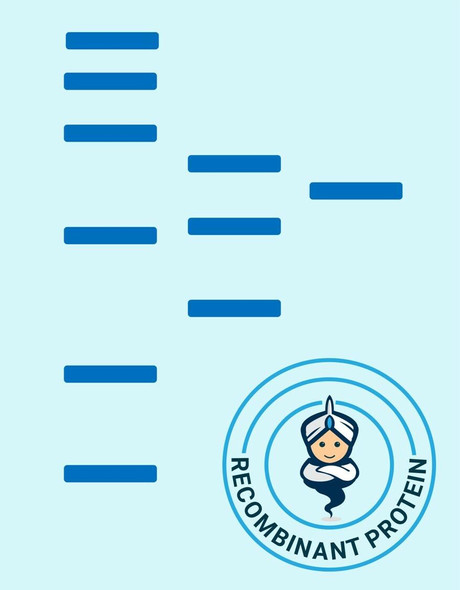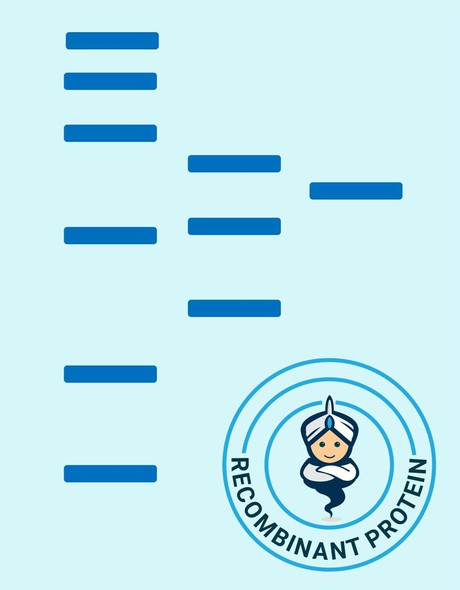Growth Factors & Cytokines Recombinant Proteins
Mouse FGF 1 Recombinant Protein (RPPB0203)
- SKU:
- RPPB0203
- Product Type:
- Recombinant Protein
- Species:
- Mouse
- Uniprot:
- P61148
- Research Area:
- Growth Factors & Cytokines
Description
| Product Name: | Mouse FGF 1 Recombinant Protein |
| Product Code: | RPPB0203 |
| Size: | 20µg |
| Species: | Mouse |
| Target: | FGF 1 |
| Synonyms: | HBGF-1, ECGF-beta, FIBP, FGFIBP, FIBP-1, ECGF, ECGFA, GLIO703, FGF1, FGF-a. |
| Source: | Escherichia Coli |
| Physical Appearance: | Sterile Filtered colorless clear solution. |
| Formulation: | FGF-1 protein solution (1mg/ml) containing 20mM Tris-HCl buffer (pH 8.0), 1mM DTT, 30% glycerol and 0.1M NaCl. |
| Stability: | Store at 4°C if entire vial will be used within 2-4 weeks.Store, frozen at -20°C for longer periods of time. For long term storage it is recommended to add a carrier protein (0.1% HSA or BSA).Avoid multiple freeze-thaw cycles. |
| Purity: | Greater than 90.0% as determined by SDS-PAGE. |
| Amino Acid Sequence: | MGSSHHHHHH SSGLVPRGSH MFNLPLGNYK KPKLLYCSNG GHFLRILPDG TVDGTRDRSD QHIQLQLSAE SAGEVYIKGT ETGQYLAMDT EGLLYGSQTP NEECLFLERL EENHYNTYTS KKHAEKNWFV GLKKNGSCKR GPRTHYGQKA ILFLPLPVSS D |
Acidic fibroblast growth factor is a member of the fibroblast growth factor (FGF) family. FGF family members possess broad mitogenic and cell survival activities, and are involved in a variety of biological processes, including embryonic development, cell growth, morphogenesis, tissue repair, tumor growth and invasion. This protein functions as a modifier of endothelial cell migration and proliferation, as well as an angiogenic factor. It acts as a mitogen for a variety of mesoderm- and neuroectoderm-derived cells in vitro, thus is thought to be involved in organogenesis. Three alternatively spliced variants encoding different isoforms have been described. The heparin-binding growth factors are angiogenic agents in vivo and are potent mitogens for a variety of cell types in vitro. There are differences in the tissue distribution and concentration of these 2 growth factors.
FGF-1 Mouse Recombinant produced in E.Coli is a single, non-glycosylated polypeptide chain containing 161 amino acids (16-155 a.a) and having a molecular mass of 18kDa (Molecular weight on SDS-PAGE will appear higher).FGF-1 is fused to a 21 amino acid His-tag at N-terminus & purified by proprietary chromatographic techniques.
| UniProt Protein Function: | FGF1: Plays an important role in the regulation of cell survival, cell division, angiogenesis, cell differentiation and cell migration. Functions as potent mitogen in vitro. Monomer. Homodimer. Interacts with FGFR1, FGFR2, FGFR3 and FGFR4. Affinity between fibroblast growth factors (FGFs) and their receptors is increased by heparan sulfate glycosaminoglycans that function as coreceptors. Found in a complex with FGFBP1, FGF1 and FGF2. Interacts with FGFBP1. Part of a Cu(2+)-dependent multiprotein aggregate containing FGF1, S100A13 and SYT1. Interacts with SYT1. Interacts with S100A13. Belongs to the heparin-binding growth factors family. 2 isoforms of the human protein are produced by alternative splicing. |
| UniProt Protein Details: | Protein type:Motility/polarity/chemotaxis; Cell development/differentiation; Cytokine Cellular Component: nucleoplasm; proteinaceous extracellular matrix; extracellular space; cytoplasm; extracellular region; nucleolus; cytosol; nucleus Molecular Function:heparin binding; protein binding; growth factor activity; Hsp70 protein binding; receptor binding; fibroblast growth factor receptor binding Biological Process: fibroblast growth factor receptor signaling pathway; positive regulation of transcription, DNA-dependent; multicellular organismal development; positive regulation of cholesterol biosynthetic process; cardiac muscle cell proliferation; cell proliferation; positive regulation of MAP kinase activity; positive regulation of angiogenesis; induction of an organ; positive regulation of cell division; positive regulation of cell proliferation; positive regulation of transcription from RNA polymerase II promoter; angiogenesis; positive regulation of protein amino acid phosphorylation; cell differentiation; positive regulation of epithelial cell proliferation; positive regulation of cell migration; lung development |
| UniProt Code: | P61148 |
| NCBI GenInfo Identifier: | 47117679 |
| NCBI Gene ID: | 14164 |
| NCBI Accession: | P61148.1 |
| UniProt Secondary Accession: | P61148,P10935, |
| UniProt Related Accession: | P61148 |
| Molecular Weight: | 17,418 Da |
| NCBI Full Name: | Fibroblast growth factor 1 |
| NCBI Synonym Full Names: | fibroblast growth factor 1 |
| NCBI Official Symbol: | Fgf1�� |
| NCBI Official Synonym Symbols: | Fam; Fgfa; Dffrx; Fgf-1�� |
| NCBI Protein Information: | fibroblast growth factor 1; aFGF; HBGF-1; acidic fibroblast growth factor; heparin-binding growth factor 1; fibroblast growth factor 1 (acidic) |
| UniProt Protein Name: | Fibroblast growth factor 1 |
| UniProt Synonym Protein Names: | Acidic fibroblast growth factor; aFGF; Heparin-binding growth factor 1; HBGF-1 |
| Protein Family: | Fibroblast growth factor |
| UniProt Gene Name: | Fgf1�� |
| UniProt Entry Name: | FGF1_MOUSE |






